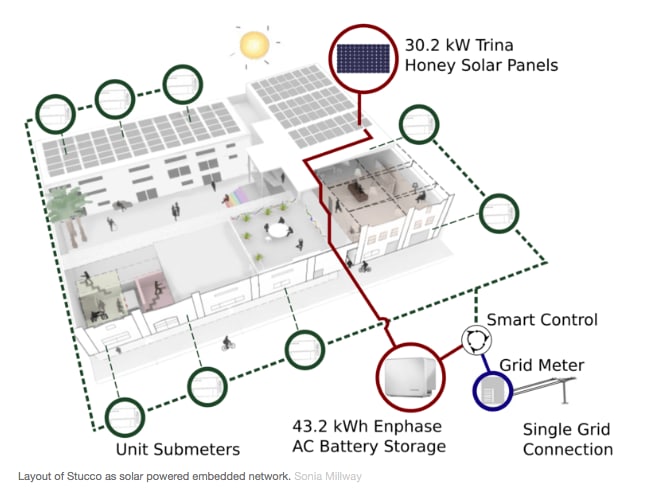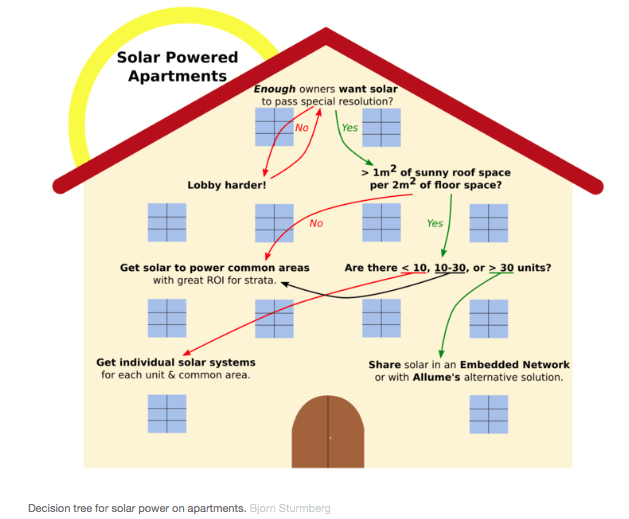Get in on the ground floor: how apartments can join the solar boom
![]() GUEST OBSERVER
GUEST OBSERVER
While there are now more solar panels in Australia than people, the many Australians who live in apartments have largely been locked out of this solar revolution by a minefield of red tape and potentially uninformed strata committees.
In the face of these challenges, Stucco, a small co-operative housing block in Sydney, embarked on a mission to take back the power. Hopefully their experiences can serve as a guide to how other apartment-dwellers can more readily go solar.
From an energy perspective, Stucco was a typical apartment block: each of its eight units had its own connection to the grid and was free to choose its own retailer, but was severely impeded from choosing to supply itself with on-site renewable energy.
Things changed in late 2015 when the co-op was awarded an Innovation Grant from the City of Sydney with a view to becoming the first apartment block in Australia to be equipped with solar and batteries.
A central part of Stucco’s plan was to share the locally produced renewable energy by converting the building into an “embedded network”, whereby the building has a single grid connection and manages the metering and billing of units internally.
Such a conversion seemed like an ideal solution for solar on apartments, but turned into an ideological battle with the electricity regulator that took months and hundreds of hours of pro bono legal support to resolve.
In this way the Stucco project grew to embody the struggle at the heart of the Australian electricity market: a battle between choice and control, between current regulations that mandate consumers to choose between incumbent retailers, and the public’s aspirations for green self-sufficiency.

A chicken and egg problem
Embedded networks have been around for decades. Yet if the Australian Energy Regulator had its way, they would be banned as soon as possible.
The reason for this is that they inhibit consumers’ choice of retailer: consumers are forced to buy their electricity from the building’s embedded network management company, which may exploit its monopoly power.
Yet it doesn’t have to be this way. At least one company in Germany allows apartment residents to buy power either from their preferred grid retailer or from the building’s solar-powered embedded network. This business model relies on Germany’s smart meter standards that ensure all market participants can access the data they require.
We currently find ourselves in a standoff. The regulator is waiting on companies to offer solar powered embedded networks that include retail competition, while companies are waiting on the regulator to create an accessible playing field that would make such services viable.
The recently released Finkel Report touches on this by recommending a “review of the regulation of individual power systems and microgrids”.
Stucco’s bespoke solution
In the absence of such a solution, Stucco made a unique agreement with the regulator: the co-op committed to cover fully the costs of installing a grid meter for any unit whose occupant wishes to exit the embedded network in the future.
Such a commitment was feasible because Stucco’s residents, as co-op members, have direct input into the management of the network including controlling prices (that are mandated to be cheaper than any grid offer). But it is difficult to image regular strata committees accepting such liabilities.
Embedded networks are therefore not the best general solution for retrofitting solar on apartments, at least not under current regulations. This is unfortunate because they represent the best utilisation of an apartment block’s solar resource (Stucco’s system provides more than 75% of the building’s electricity) and are therefore increasingly being adopted by developers.
Advice for apartments

The good news for residents of existing apartments is that there are easier routes to installing solar. The even better news is that the cost of solar systems has plummeted (and continues to do so), while retail rates continue to skyrocket, so much so that body corporates are reporting rates of return of 15-20% on their solar investments.
The recommended options for apartments are epitomised by the old adage “keep it simple”. They fall into two categories: a single solar system to power the common area, or multiple smaller systems powering individual units. Which of these is best suited to a particular apartment depends primarily on the building’s size (as a proxy for its energy demand).
For buildings with 1 square metre of sunny roof space per 2m² of floor space (typically blocks up three stories high), it is worth installing a solar system for each unit, as these will typically be well matched to unit’s consumption.
Taller buildings (with less sunshine per apartment) are better off installing a single system for the common area, particularly if this contains power-hungry elements such as elevators or heating and cooling systems.

But here’s the crux: no apartment can install solar without the political support of its strata committee. While this hurdle has historically tripped up many initiatives, increased public awareness has created a groundswell of support. Plus you may need fewer votes than you think.
While this article focuses on solar, it is important to remember that the first priority for any building should be to improve energy efficiency, by installing items such as LED lights, modern appliances, and insulation and draft proofing. For advice on these opportunities see the City of Sydney’s Smart Green Apartments website and the Smart Blocks website.
Lastly, adding batteries to an apartment solar system creates extra challenges, for instance fire-prevention planning. But it allows for far greater energy independence and resilience, and a chance to join the future of distributed energy currently being enjoyed by so many of Australia’s non-strata householders.
Bjorn Sturmberg is Associate Lecturer in Physics, Macquarie University and author for The Conversation. He can be contacted here.
